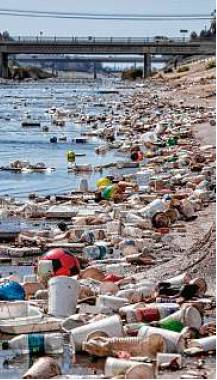TOMLINSON’S TAKE
Plastic use is growing — and causing some health problems
CHRIS TOMLINSON Commentary
There is no foreseeable limit to our growing appetite for plastic.
The global demand for polyethylene, the petrochemical used to make plastic products, will grow between 2 percent and 3 percent a year through 2050, according to IHS Markit, an energy industry consulting and data analysis firm.
Unless we change our habits, our absurd desire for single-use plastic straws, utensils, packaging and the millions of other plastic bits we throw away will profoundly damage our water and landscapes as well as our health.
“Polyethylene demand is dominated by non-durable uses, representing approximately 60 percent of total global demand,” IHS experts concluded in a new report. “Furthermore, packaging represents most of the non-durable applications.”
Polyethylene is made from crude and natural gas, and the fossil fuel industry is counting on demand for plastic to grow. Every time we use a plastic bag to carry a Styrofoam box holding our lunch, and every time we sip iced tea from a straw in a single-use plastic cup, we make an oil and gas executive happy. We also damage our world.
Don’t pat yourself on the back if you put your plastic in the recycling. Only 9 percent of plastic is recycled globally, and type 1 PET and 2 HDPE are the only ones with commercial value. Most soft plastics and the other types end up in landfills, if we’re lucky.
Turning a single-use plastic product into a reusable material is difficult and expensive.
Types 1 and 2 can go into mechanical shredders, and the mulch ends up in park benches and recycling containers. IHS estimates that by 2050, mechanically recycled resins could meet between 17 percent and 33 percent of global demand if we agree to strict recycling laws.
Chemical recycling, where used plastic is dissolved back into polyethylene, is very complicated and expensive. But if the plastics industry can increase efficiency and bring costs down, chemical recycling offers the best chance at effective recycling.
Last month, chemical giant Eastman announced a $1 billion investment to build a French plant capable of recycling up to 160,000 metric tons annually of “hard-to-recycle plastic waste that is currently being incinerated.” The company said it has commitments from Estée Lauder and Procter & Gamble to buy the recycled products.
Kraft Heinz, Target, Keurig Dr Pepper and Walmart have also pledged to buy more recycled plastic for their packaging. Unilever promised in 2019 to reduce virgin plastic use by 50 percent, including eliminating 100,000 tons of plastic packaging by 2025.
Unilever has the right idea, but announced projects will not make a dent in demand for plastic, IHS reported. Based on current market conditions and proposed legislation, the best we can hope for is to increase recycled content and reduce the use of virgin polyethylene. Total plastic use will keep going up.
“Without a significant decline in the overall demand trajectory for polyethylene, a peak in fossil-based production will not occur before 2043,” said Robin Waters, director of IHS’s Circular Plastics Service.
Pumping oil and gas from the ground and spewing plastic waste across the plant at the current pace will have profound consequences. The problem is more than old flip flops washing up on the beach, but microscopic bits of plastic in the water we drink and the air we breathe.
We have long known we are ingesting microplastics, but scientists are just beginning to understand the problems they cause. Microscopic bits of plastic can build up in our internal organs and even change our metabolism.
Plastic food packaging can carry 4,000 chemicals, according to the Norwegian University of Science and Technology. Scientists at the World Health Organization have found that plastic residues carry several endocrine disruptors that get into our food and may promote the growth of fat cells, or adipocytes, which contribute to obesity.
Doctors at Arizona State University found a plastic byproduct, bisphenol A, in all the liver samples they studied from recent autopsies. BPA is “a reproductive, developmental and systemic toxicant in animal studies,” according to the Environmental Protection Agency.
Consumers have long ignored the plastic trash that litters every corner of the United States. We’ve learned to live with plastic killing wildlife, especially in the ocean. IHS’s research shows demand for single-use plastic products has kept rising, especially during the COVID-19 pandemic.
But will we care more when people realize microplastics disrupt our fertility, cause weight gain and shorten our lives?
IHS says the only things that will slow demand for plastic are strict bans on single-use plastic products and mandatory recycling. We’re always going to need plastic; we just need to value common sense over convenience.
Tomlinson writes commentary about business, economics and politics. twitter.com/cltomlinsonchris.tomlinson@chron.com


